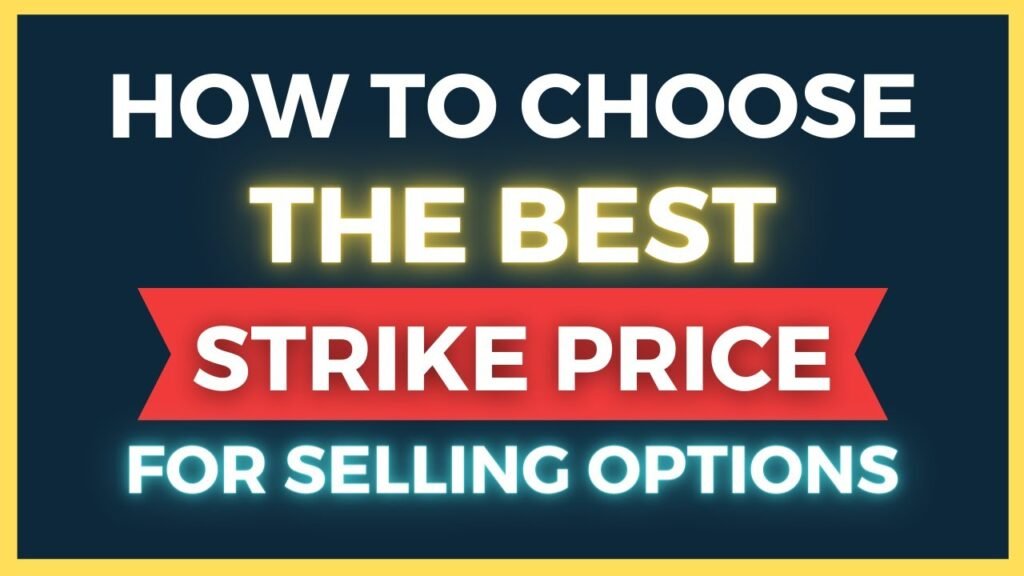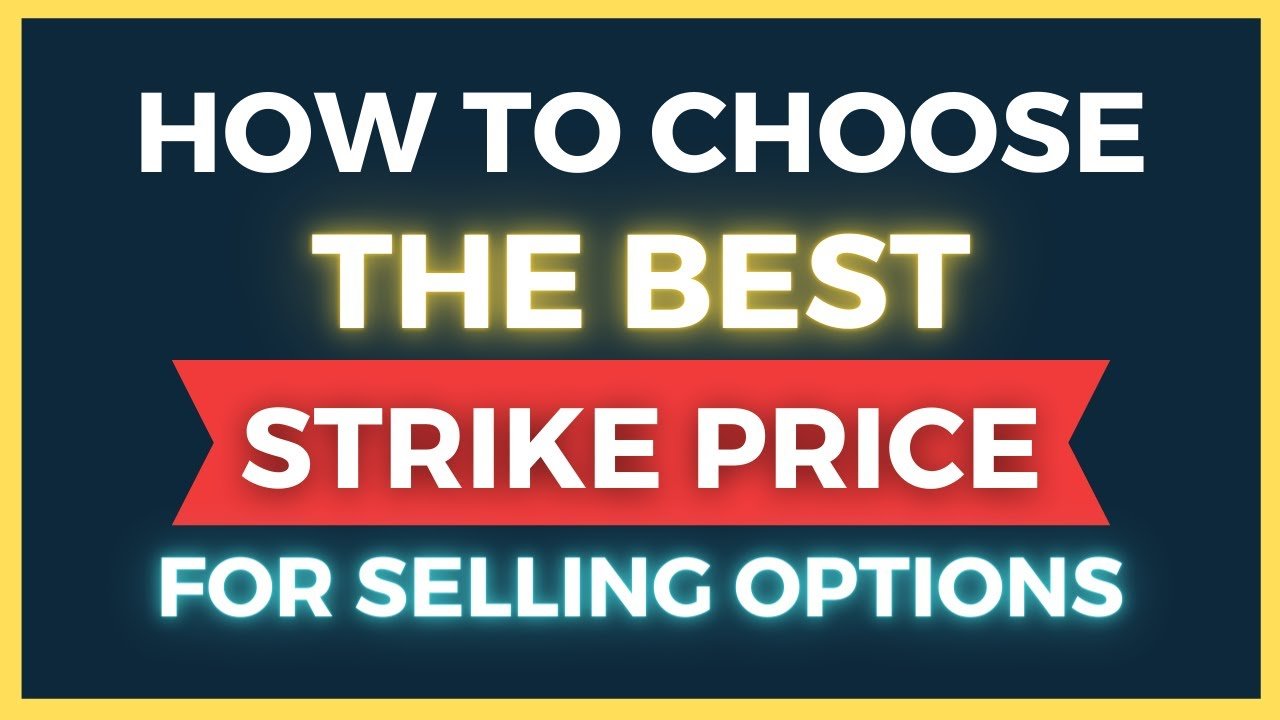Looking to learn how to choose the best strike price for selling options? Options with Davis has got you covered! In his informative video, Davis explores the debate between selecting a strike price with a juicy premium and a high win rate. He reveals the best strike price and discusses two key elements to consider when making your decision. Davis also shares a fast and efficient way to identify the best strikes on a chart. Whether you’re new to options trading or looking to optimize your strategies, this video provides valuable insights. So, get ready to enhance your options trading skills and increase your chances of success! Remember to check out other related videos and grab a free copy of The Options Income Blueprint.
Options with Davis is here to guide you on your journey to selecting the best strike price for selling options. In his video, Davis delves into the factors to consider when making this crucial decision, including premium, win rate, and probability of profit. He emphasizes the importance of finding a strike price that offers a good balance between a high probability of profit and sufficient premium. Davis also introduces useful tools like Delta and the expected move to help determine the probability of the strike price being in the money. Additionally, he discusses how the Probability of Expiring Cone indicator on the Thinkorswim platform can aid in identifying the expected move on the chart. With Davis’s expert advice, you’ll be equipped to make more informed decisions and increase your chances of success in options trading. Don’t miss out on this valuable resource!
Factors to Consider when Choosing a Strike Price
When it comes to choosing the best strike price for selling options, there are several factors to consider. The strike price refers to the price at which an option can be exercised or bought/sold. It plays a crucial role in determining the profitability and success of an options trade.
Premium
One of the key factors to consider when choosing a strike price is the premium. The premium refers to the price that the option buyer pays to the option seller for the right to buy or sell the underlying asset at the specified strike price. Choosing a strike price with a higher premium can result in greater profits if the option expires in the money. However, it’s important to strike a balance between premium and win rate, as a higher premium may also come with a lower win rate.
Win Rate
The win rate is another important factor to consider when choosing a strike price. The win rate refers to the percentage of options trades that result in a profit. While a higher win rate can be desirable, it may come at the cost of a lower premium. Traders need to weigh the potential profitability against the probability of success when selecting a strike price based on win rate.
Probability of Profit
The probability of profit is a crucial factor in determining the suitability of a strike price. It refers to the likelihood that an option trade will be profitable based on the current market conditions, volatility, and other factors. Delta and expected move are two indicators that can help determine the probability of profit.
Determining Probability of the Strike Price
To determine the probability of a strike price being in the money, traders can use the delta and the expected move.
Using the Delta
The delta is a measure of how much an option price is expected to change for every one-point change in the underlying asset. It can also be used to estimate the probability of an option expiring in the money. For example, an option with a delta of 0.20 indicates a 20% chance of being in the money at expiration. By selecting strike prices with higher delta values, traders can increase the probability of profit.
Expected Move
The expected move is an estimation of the range in which the underlying asset’s price is expected to move by a certain date, based on its current level of implied volatility. Traders can calculate the expected move by using various mathematical models. By choosing strike prices within the expected move range, traders can increase the probability of profit as the stock price is more likely to stay within that range.

Choosing Strike Prices
When it comes to choosing strike prices, there are several ranges and indicators that can help traders make informed decisions.
16 Delta Range
Using the 16 Delta range involves selecting strike prices that have a delta of around 0.16. This range is often considered a sweet spot as it provides a good balance between probability of profit and premium. By choosing strike prices within this range, traders can increase their chances of success while still receiving a decent premium.
15-30 Delta Range
Another range commonly used is the 15-30 Delta range. This range expands the options for strike prices and provides a wider selection based on the desired balance between win rate and premium. By choosing strike prices within this range, traders have more flexibility in their trading strategies.
Probability of Expiring Cone Indicator
The Probability of Expiring Cone indicator on platforms such as Thinkorswim can be a valuable tool for selecting strike prices. This indicator displays the expected move of the underlying asset on a chart. By analyzing the cone shape and the expected move, traders can identify potential strike prices that align with their preferred balance of win rate and premium.
Using the Probability of Expiring Cone
The Probability of Expiring Cone can be utilized in different trading strategies to determine strike prices.
Different Trading Strategies
Various trading strategies, such as covered calls, wheel strategy, credit spreads, and iron condors, can benefit from using the Probability of Expiring Cone.
Covered Call
For a covered call strategy, the strike price should be chosen slightly above a resistance level and around the expected move. This allows traders to collect a premium while still having a high probability of profit.
Wheel Strategy
In the wheel strategy, the strike price for selling a cash-secured put should be chosen below a support area. By selecting strike prices within the expected move range, traders can increase their chances of success while still receiving a decent premium.
Credit Spreads
When utilizing credit spreads, traders can choose strike prices based on the probability of expiring cone. By analyzing the expected move and selecting strike prices within that range, traders can increase the probability of profit and still receive a favorable premium.
Iron Condor
The iron condor strategy combines a bull put spread and a bear call spread. The probability of expiring cone can help determine the strike prices for both the put and call spreads. By selecting strike prices within the expected move range, traders can increase their chances of success while still receiving a suitable premium.
Determining Strike Prices for Specific Strategies
Each trading strategy may have specific guidelines for choosing strike prices.
Covered Call
For a covered call strategy, the strike price should be chosen slightly above a resistance level and around the expected move. This ensures that the stock price is more likely to stay below the strike price, allowing traders to collect the premium and potentially profit from the stock’s appreciation.
Wheel Strategy
In the wheel strategy, the strike price for selling a cash-secured put should be chosen below a support area. By selecting strike prices within the expected move range, traders can increase their chances of success while still receiving a decent premium.
Credit Spreads
When utilizing credit spreads, traders can choose strike prices based on the probability of expiring cone. By analyzing the expected move and selecting strike prices within that range, traders can increase the probability of profit and still receive a favorable premium.
Iron Condor
The iron condor strategy combines a bull put spread and a bear call spread. The probability of expiring cone can help determine the strike prices for both the put and call spreads. By selecting strike prices within the expected move range, traders can increase their chances of success while still receiving a suitable premium.
Using the Probability of Expiring Cone to Determine Expiration Date
The Probability of Expiring Cone can also assist in determining the expiration date for options. By analyzing the cone shape and the expected move, traders can make informed decisions about the duration of the options contract. For example, if the cone indicates a wide range of expected move, traders may opt for a longer expiration date to allow for more flexibility and potential profit.
Benefits of Using the Probability of Expiring Cone
Utilizing the Probability of Expiring Cone can provide several benefits for traders.
Informed Decision Making
By incorporating the Probability of Expiring Cone into the decision-making process, traders can make more informed choices about strike prices and expiration dates. This can enhance their overall trading strategy and increase the probability of success.
Increased Chances of Success
Choosing strike prices within the expected move range increases the chances of success for options trades. By aligning strike prices with the predicted movement of the underlying asset, traders can mitigate risks and maximize profits.
Conclusion
Choosing the best strike price for selling options involves considering various factors such as premium, win rate, and probability of profit. By utilizing tools like the delta and expected move, traders can assess the probability of strike prices being profitable. The Probability of Expiring Cone indicator further aids in strike price selection, leading to more informed decisions and increased chances of success in options trading.
